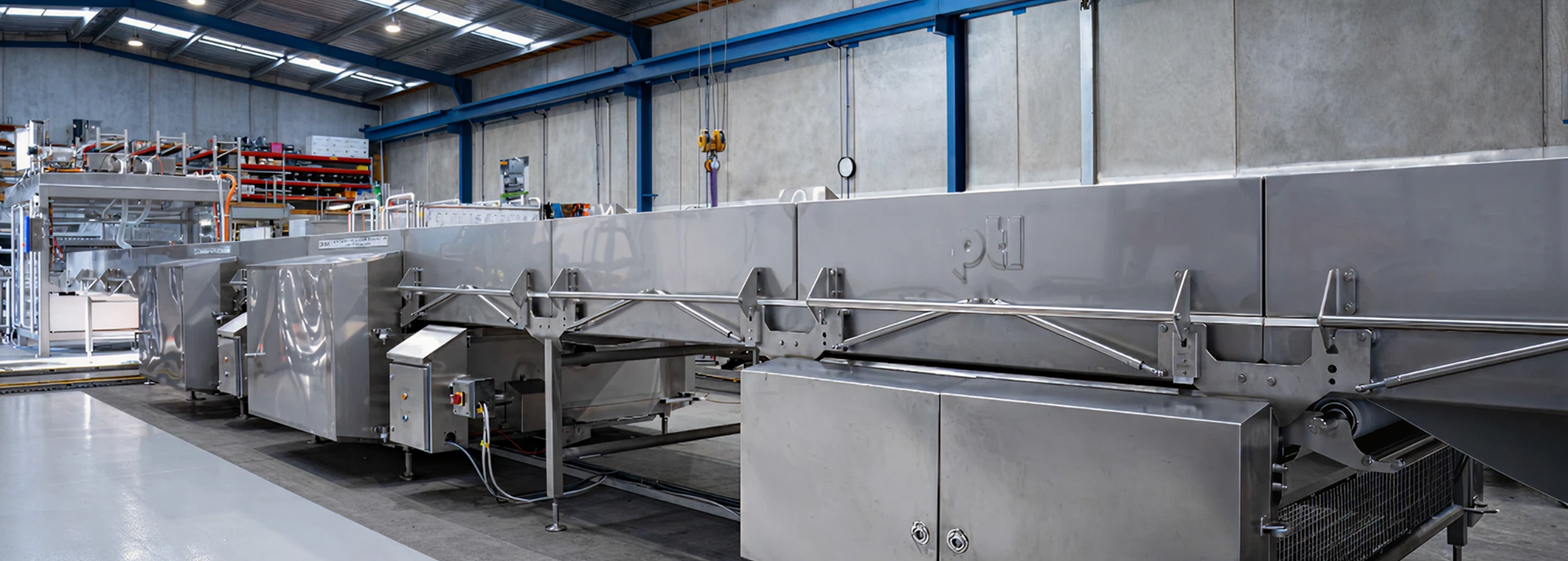Hygienic design: clean, lean, and poised for expansion
Hygienically designed equipment allows cleaning to a microbiological level over the lifetime of the machine. Often, equipment shows its age in the form of pitting, cracks, corrosion, or protruding edges where product can collect

Do more with less – that’s the goal of any food manufacturing business, and hygiene is often seen as a production-slowing extra. In reality, exceptional hygiene is essential to remaining competitive in the industry. It’s key to protecting your business continuity while minimizing waste and expanding SKUs to meet the market.
Exceptional hygiene practices enable you to:
1. Support SKU proliferation
When you can quickly and easily switch between SKUs, you’re not limited. Between customization, special editions and personalization runs, you have the freedom to pivot quickly and meet market opportunities as you see them without huge overheads.
2. Minimize risk of fines and lawsuits
If food from your facility causes outbreaks of illness, your executives and food safety managers could be handed a monetary fine for failing to resolve known food safety issues. Damage to people’s health from allergic reactions or food-borne illness also leaves you vulnerable to lawsuits, which can prove cripplingly expensive, even if you can show you’re not at fault.
3. Avoid product recalls
2021 saw 38 recalls issued in the U.S. for a total of 14,486,371 pounds of wasted product. This is a very real danger to your customer loyalty and supplier relationships, and to your bottom line in lost sales, wasted time, and hard costs.
4. Protect brand reputation
Your brand is everything. Any whiff of slapdash hygiene, or at worst, a full-scale recall, will cause long-term brand degradation.
5. Reduce waste
Changeovers traditionally meant waste, as cross-contaminated product worked its way through the line. Great hygiene practices minimize this waste, meaning you can use more of each run.
Build industry-leading hygiene practices
Excellent hygiene practices in your food manufacturing plant take a multi-pronged approach, considering your processes, people, and equipment.
Choose equipment with hygienic design
Not all equipment is created equal. Lower-cost models are rarely built to meet the fast pace and exacting standards of the modern manufacturing environment. Hygienically designed equipment allows cleaning to a microbiological level over the lifetime of the machine. Often, equipment shows its age in the form of pitting, cracks, corrosion, or protruding edges where product can collect. In hard-to-reach places, this wear makes it almost impossible to remove all food materials or manage bacterial growth.
Your machinery must also be compatible with food products, the working environment, and standard sanitizing products while being easy to inspect and clean. Look for self-draining equipment with hollow areas hermetically sealed, and consider hygiene around maintenance enclosures and anywhere that humans interface with the machine.
A big part of what makes our machines so easy to clean is our early innovation around removable components. When you can remove each component to a wash-down area using a purpose-built trolley, your cleaning process is completed in a fraction of the time. If you have a second component, your machine can be back in commission almost immediately – simply slot the new one in. Read our eBook and adoption checklist – 10 hygienic design principles for food manufacturing.
Invest in team training and instruction
Poor processes and training can let down excellent equipment, as teams introduce contaminants through a lack of knowledge or negligence. The ideal is to choose equipment that factors for these human behaviors, but even then, you need to support your team with on-site training and easy-to-follow instructions. This necessity led the PTL team to add etched instructions to the machines, making them immediately accessible and not sitting on a shelf in a dusty manual. It’s also why our people who assemble and test the machinery are the same technicians who oversee the installation and training.
Make hygiene practices easy
In an equipment-heavy industry like manufacturing, you’re still working with – or against – human nature. Even gold-star workers who care about your business success and output quality will have off days. If a process is longwinded, physically demanding, fiddly, or boring, you’re more likely to see staff cutting corners.
“As designers, it’s our job to take that out of the equation. We want to make it almost a pleasure to take things to bits so they can be cleaned,” says PTL founder Jim Halliday.
The user-friendliness of our equipment has been refined over 35 years to make equipment easy to clean properly. It means your people are more likely to do it and do it well without the need for heavy oversight from management. That attention to detail was part of what impressed Tru Food Manufacturing.
“What was obvious was the amount of time and thought that had been put into all aspects of the machine. This equates to ease of use, ease of sanitation, minimal downtime for sanitation, and flexibility to switch between products to keep up with our customers’ demands.” – Mike Berko, Project Engineer.
Hygiene could be your edge
Your long-term business viability isn’t just about efficiency and productivity – it’s dependent on fast and simple hygienic practices too. Doing that isn’t easy – you first need equipment with built-in, best-practice hygiene features designed to make cleaning almost enjoyable. Add rigorous team training to the mix, and you’ll be positioned to expand your SKUs, jump on market opportunities, and know your business and reputation are protected.
Learn how PTL’s hygienically designed equipment and in-depth training could supercharge your facility – get in touch.